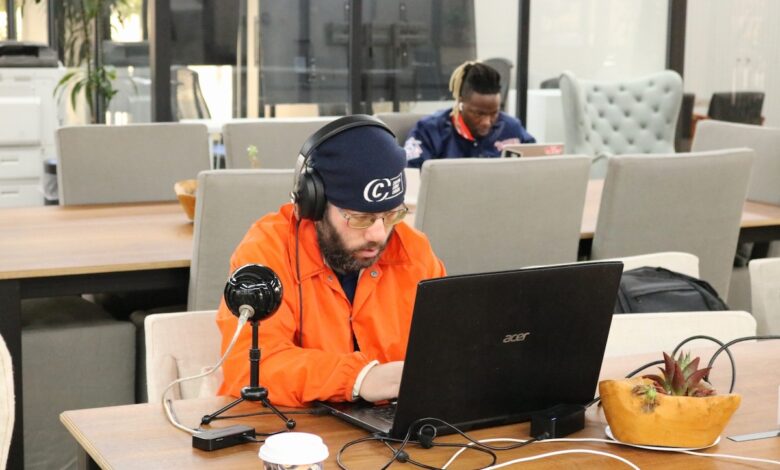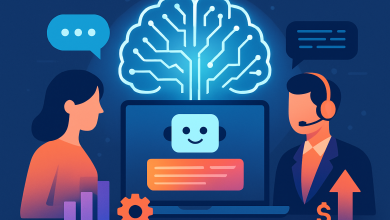
The AI skills gap is widening: By 2030, the World Economic Forum predicts that 44% of workers’ core skills will be disrupted. Meanwhile, AI job postings in the U.S. are up 20% year-over-year, according to the Stanford AI Index. But the real crisis isn’t a shortage of talent. It’s the absence of systems to help people develop these skills fast enough to meet demand. That’s where apprenticeships come in as a win-win to bridge the gap, not only for employers’ benefit, but for job-seekers too.
The Real Talent Gap
Global employers report that core skills are changing at an unprecedented rate. The World Economic Forum’s latest Future of Jobs analysis reveals sweeping shifts in skills needs through 2030, driven by technology and the green transition. That change window is measured in months and quarters—not academic program cycles.
In the U.S., demand for AI skills keeps climbing—the Stanford AI Index shows AI-skill postings up 20% year-over-year (2023 to 2024), with the U.S. leading in absolute volume.
Meanwhile, a recent report from Georgetown University shows that experienced talent is retiring faster than similarly prepared workers are entering the labor market. From 2024 to 2032, 18.4M experienced workers with postsecondary education are expected to retire, outpacing the 13.8M young workers entering with equivalent preparation. That structural math guarantees persistent shortages unless we grow talent differently.
The crisis isn’t a lack of people—it’s a lack of systems that help people acquire validated, job-relevant skills quickly and at scale.
Why Degree First Hiring Widens the Gap
Relying on 4-year degrees as the primary hiring filter may have worked in a slower economy, but it is dangerously out of step with the velocity of AI. By clinging to outdated degree requirements, companies are not only shutting out capable candidates but also widening the talent gap at a time when businesses need adaptable, AI-ready workers the most.
- College curriculum lags: Accreditation and course redesign take time. There’s simply no way that higher education institutes can keep up with how quickly AI changes. By the time a syllabus stabilizes, the stack has shifted.
- Degrees don’t equal skills: A diploma might look impressive, but it doesn’t always prove someone can actually do the work. Employers need evidence of real skills that matter on the job. (prompting, model evaluation, data governance, RAG patterns, human-in-the-loop QA).
- Equity and access: Requiring a degree shuts out nontraditional talent—including people from underrepresented communities who can acquire skills quickly with the right on-the-job scaffolding.
The Case for Skills-Based Hiring
Most employers say they want the “best talent,” but too often, they still use degrees as a shortcut for identifying capability. That approach doesn’t work in the age of AI. Skills are changing too fast, and they rarely line up neatly with a diploma, which is why we need to shift to skills-based hiring.
- Faster hiring cycles: Employers can identify candidates who already demonstrate needed skills, instead of waiting for the next graduating class. I’ve seen this firsthand many times over in my organization, where someone with no prior coding experience learns the skills and gets hired as a developer, all within 4-6 months.
- Lower cost-to-hire: By tapping into overlooked talent pools, companies avoid costly bidding wars for the same narrow set of degree-holders.
- Higher retention: If you invest in people with on-the-job learning, and hire people for their abilities, they’re usually more loyal to the company that gave them a chance, and less likely to leave.
In my organization, Creating Coding Careers (CCC), we’ve seen firsthand how skills-based hiring creates a stronger, more resilient workforce. Instead of assuming someone has the right skills because of a diploma, employers watch apprentices demonstrate them in real time—while also learning the company’s unique processes.
AI Accelerates Early Talent
I hear it constantly: “AI will eliminate junior roles.” My experience says the opposite. With AI copilots and structured mentorship, early-career hires ramp faster and contribute sooner. The Stanford AI Index synthesizes mounting evidence that AI boosts productivity and can narrow certain skill gaps when paired with human oversight.
What changes with AI-augmented juniors:
- Faster onboarding through guided generation, code explanation, and test synthesis
- Real-time feedback loops (linting, doc generation, pattern suggestions) that compress learning cycles
- Managers move from gatekeeping to coaching, supervising higher-value problem framing and review.
This is not a “humans vs. AI” choice. It’s humans plus AI, organized so that capability compounds.
The Missing Link: Registered Apprenticeships for AI Roles
At Creating Coding Careers (CCC), the nonprofit I lead, we build earn-and-learn programs that blend related instruction with paid, supervised, real work. We’ve watched career-switchers and early-career talent move into software engineering, cybersecurity, and data roles—without a computer science degree—because employers could see and measure competence on the job.
Why apprenticeships fit AI work:
- Skills validation Competencies are defined with employers (e.g., data curation, evaluation metrics, prompt safety, lineage tracking), assessed in production contexts, and iterated as tools evolve.
- Time-to-productivity Apprentices contribute immediately on scoped tasks, adding value while they learn.
- Retention and ROI U.S. Department of Labor research on the American Apprenticeship Initiative found positive employer return on investment; complementary federal data reports ~90% employment retention post-completion—stickiness degree-first pipelines struggle to match.
- Inclusion by design Paid training lowers barriers for overlooked talent (veterans, working parents, first-gen learners), broadening the AI workforce.
- High Demand CCC was recently awarded a grant to expand apprenticeship pathways—including AI engineer apprenticeships. This recognition underscores how earn-and-learn models are central to solving the AI workforce shortage.
Apprenticeship Outcome: Alfred’s Journey to Software Developer in 10 months
Running an apprenticeship program at Creating Coding Careers has given me the privilege to witness countless transformations. One apprentice who stands out is Alfred.
After eight years in the Marine Corps, Alfred faced the uncertainty of civilian life. As he put it:
“Anybody that’s transitioning out of the military would tell you, it’s like an emotional rollercoaster.”
He didn’t have a computer science degree or coding background—just an interest in technology and the determination to start fresh.
Through our Department of Defense SkillBridge program, Alfred started training with us at CCC. Within five months, he learned the foundations of software development and earned a spot in our partner company ServiceNow’s STAR apprenticeship program.
Just five months later, ServiceNow managers felt confident in his abilities to offer Alfred a full-time, six-figure developer role with benefits, bonuses, and stock options. ServiceNow gained a skilled, loyal developer—without waiting on a degree pipeline. Alfred described the moment:
“Getting the offer letter was phenomenal… It was surreal. I didn’t think I would be in a Fortune 500 company doing software engineering.”
Nearly two years later, Alfred is still thriving at ServiceNow, proving the long-term retention benefits of apprenticeships. His journey proves that apprenticeships don’t just train people for jobs—they transform lives, open doors for overlooked talent, and give companies loyal, motivated employees who want to grow with the organization. This is the exact model we can use to solve the AI skills gap.
Where to Place AI Apprentices First (High-Leverage Use Cases)
- Evaluation engineering & red-teaming: Define test sets, write eval harnesses, track regressions, document failure modes, monitor cost/latency.
- Knowledge engineering for RAG: Curate sources, chunking strategies, metadata policies, safety filters, and retrieval metrics.
- Ops & observability: Build dashboards for drift, hallucination rates, prompt versioning, and user feedback loops.
- Responsible AI support: Assist with data governance, audit trails, and compliance documentation across model updates.
These domains are teachable, constrained, and business-critical—ideal for apprentices to add value early.
What Policymakers and Funders Can Do Now
1) Incentivize skills verification. Shift grants and tax credits toward measurable competencies delivered on the job rather than time-in-seat programs.
2) Modernize data systems. Fund shared infrastructure for apprenticeship data (wage progression, completion, demographic equity, competency attainment) so programs can benchmark and improve. DOL highlights the need for better RA data infrastructure to scale what works.
3) Expand apprenticeship into AI-adjacent sectors. Support employer consortia to set baseline AI competencies for healthcare, public sector, energy, and manufacturing, then align RA standards accordingly.
4) Reward employer mentorship. Offset mentor time; the quality of coaching determines whether AI + early talent truly accelerates capability.
Common Objections—and Field-Tested Responses
Q: “We don’t have the budget.”
A: Apprenticeships are a long-term strategy that saves money.
Many companies like Microsoft, Google, and Amazon invest in apprenticeships as a strategic imperative, recognizing the long-term cost savings over short-term solutions. Funding doesn’t have to solely come from the company budget; there are creative funding avenues that can lower upfront costs.
Q: “We don’t have time to mentor.”
A: Mentorship turns hidden friction into an asset.
You’re already paying the cost in code review churn, rework, and recruiting. Mentorship compounds capability internally, transforming these hidden costs into a strategic advantage.
Q: “We tried dropping degree requirements; it didn’t change outcomes.”
A: You changed the policy, not the process.
Skills-based hiring requires more than just dropping degree requirements. It needs defined competencies, robust assessments, and a structured runway for on-the-job learning. Apprenticeships provide this essential process. Research confirms this.
Q: “Will quality slip if juniors touch AI?”
A: Quality improves with proper instrumentation.
Quality actually improves when work is instrumented with evaluation harnesses, safety gates, and human-in-the-loop reviews. Apprentices operate effectively within these well-defined guardrails.
A Broader Economic Lens: Why This Matters Beyond Tech
The Future of Jobs research forecasts tens of millions of new roles created by macro trends this decade. But growth without inclusive on-ramps risks widening inequality. Apprenticeships are a proven way to share AI’s productivity gains more broadly—by paying people to learn, validating skills, and plugging local talent into high-wage work.
And while the AI debate often fixates on risk, the opportunity is clear in the aggregate data: AI can lift productivity and, with thoughtful deployment, help close skill gaps, particularly when human oversight is built into the workflow. The challenge is not whether we adopt AI, but how we train and trust the humans using it.
What Success Looks Like in 24 Months
- Funding apprenticeships with commitment from government, corporations, and philanthropic organizations.
- Investing company budget into developing apprenticeship programs with intent to hire.
- Thousands of AI-adjacent apprentices placed across evaluation, data governance, and AI ops in healthcare, finance, public sector, energy, and tech.
- A shared competency baseline adopted by employer consortia, refreshing quarterly.
- Public dashboards reporting completion, wage progression, and equity metrics for apprenticeships.
- Degree-optional job postings backed by credible, work-sample-based assessments, and actual hiring aligned to those assessments.
- Employers reporting positive ROI and above-market retention among apprenticeship completers.
That is how we turn “AI talent shortage” headlines into quiet competence—teams that learn, adapt, and deliver.
Apprenticeships as Strategic Infrastructure
If you lead a business, a workforce board, or a public agency, stop waiting for perfect resumes and start building perfect systems. Define the work. Map the skills. Pay people to learn on the job. Measure everything. Iterate.
This is not an experiment for the margins. It is the infrastructure AI requires.
At Creating Coding Careers, we’ve seen what happens when employers invest: people stay, capability compounds, and the community wins. Apprenticeships aren’t charity, they’re strategy.
The AI talent gap isn’t inevitable. If business, government, and philanthropy align around apprenticeships, we can replace fear with competence and build the workforce AI requires.
About the Author






